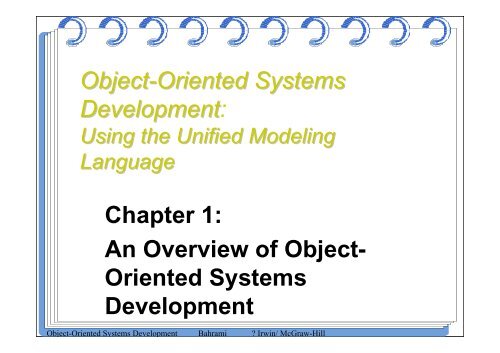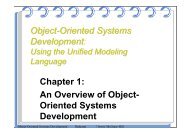Object oriemted Analysis
You also want an ePaper? Increase the reach of your titles
YUMPU automatically turns print PDFs into web optimized ePapers that Google loves.
<strong>Object</strong>-Oriented Systems<br />
Development:<br />
Using the Unified Modeling<br />
Language<br />
Chapter 1:<br />
An Overview of <strong>Object</strong>-<br />
Oriented Systems<br />
Development<br />
<strong>Object</strong>-Oriented Systems Development Bahrami ? Irwin/ McGraw-Hill
Goals<br />
• The object-oriented philosophy<br />
and why we need to study it.<br />
• The unified approach.<br />
<strong>Object</strong>-Oriented Systems Development Bahrami ? Irwin/ McGraw-Hill
Introduction<br />
• <strong>Object</strong>-Oriented (OO) systems<br />
development is a way to develop<br />
software by building selfcontained<br />
modules that can be<br />
more easily:<br />
• Replaced<br />
• Modified<br />
• and Reused.<br />
<strong>Object</strong>-Oriented Systems Development Bahrami ? Irwin/ McGraw-Hill
What is a Software development<br />
methodology?<br />
• Practices, procedures, and rules<br />
used to develop software.<br />
<strong>Object</strong>-Oriented Systems Development Bahrami ? Irwin/ McGraw-Hill
Systems Development<br />
Methodologies<br />
• Systems development<br />
methodology is a way to develop<br />
system.<br />
• A comprehensive system<br />
development methodology<br />
utilizes sets of tools as well as the<br />
style in which they are to be used.<br />
<strong>Object</strong>-Oriented Systems Development Bahrami ? Irwin/ McGraw-Hill
Traditional Systems Development<br />
Methodology<br />
• Traditional or Structured<br />
approach is based on the idea that<br />
a system can be thought of as a<br />
collection of modules or<br />
subsystems.<br />
• It is much easier to work with a<br />
smaller cohesive module than a<br />
complex system.<br />
<strong>Object</strong>-Oriented Systems Development Bahrami ? Irwin/ McGraw-Hill
<strong>Object</strong>-Oriented Systems<br />
Development Methodology<br />
• In an O-O environment, software<br />
is a collection of discrete objects.<br />
• These objects encapsulate their<br />
data and functionalities to model<br />
real world "objects."<br />
<strong>Object</strong>-Oriented Systems Development Bahrami ? Irwin/ McGraw-Hill
<strong>Object</strong>-Oriented Systems<br />
Development Methodology (Con’t)<br />
• An object-oriented life cycle<br />
encourages a view of the world as<br />
a system of cooperative and<br />
collaborating agents.<br />
<strong>Object</strong>-Oriented Systems Development Bahrami ? Irwin/ McGraw-Hill
Benefits of <strong>Object</strong> Orientation<br />
• Faster development,<br />
• Reusability,<br />
• Increased quality,<br />
• and easier maintenance.<br />
<strong>Object</strong>-Oriented Systems Development Bahrami ? Irwin/ McGraw-Hill
OO Benefits (Con’t)<br />
• <strong>Object</strong> technology emphasizes<br />
modeling the real world and provides<br />
us with the stronger equivalence of<br />
the real world’s entities (objects) than<br />
other methodologies.<br />
• Raising the level of abstraction to the<br />
point where application can be<br />
implemented in the same terms as<br />
they are described.<br />
<strong>Object</strong>-Oriented Systems Development Bahrami ? Irwin/ McGraw-Hill
Unified Approach<br />
• The unified approach (UA) is a<br />
methodology for software<br />
development that is used in this<br />
book.<br />
• The UA, based on methodologies<br />
by Booch, Rumbaugh, Jacobson,<br />
and others, tries to combine the<br />
best practices, processes, and<br />
guidelines.<br />
<strong>Object</strong>-Oriented Systems Development Bahrami ? Irwin/ McGraw-Hill
Unified Approach (Con’t)<br />
• UA utilizes the unified modeling<br />
language (UML) which is a set of<br />
notations and conventions used to<br />
describe and model an<br />
application.<br />
<strong>Object</strong>-Oriented Systems Development Bahrami ? Irwin/ McGraw-Hill
Layered Architecture<br />
• UA also uses a layered architecture<br />
to develop applications.<br />
• The layered approach consists of<br />
view or user interface, business, and<br />
access layers.<br />
<strong>Object</strong>-Oriented Systems Development Bahrami ? Irwin/ McGraw-Hill
Layered Architecture (Con’t)<br />
• This approach reduces the<br />
interdependence of the user interface,<br />
database access, and business control.<br />
• Therefore, it allows for a more robust<br />
and flexible system.<br />
<strong>Object</strong>-Oriented Systems Development Bahrami ? Irwin/ McGraw-Hill
Return<br />
Book?<br />
Go to counter<br />
Yes and return the<br />
book<br />
Borrow<br />
Yes<br />
Books?<br />
No<br />
Perform<br />
Research?<br />
No<br />
Read<br />
newspaper<br />
/books<br />
No<br />
Inter<br />
Inter Library<br />
Libray<br />
Loan Section,<br />
Yes<br />
Loan?<br />
check out<br />
book<br />
1<br />
No<br />
Yes<br />
Yes<br />
1<br />
1..<br />
*<br />
Search for the<br />
book in the<br />
library<br />
Do Research<br />
on the topic<br />
Sit<br />
somewhere<br />
quiet and read<br />
newspaper,<br />
books, etc.<br />
*<br />
1<br />
1<br />
Checking<br />
Done? Yes<br />
out Books?<br />
Go to counter<br />
and check out<br />
the book<br />
Bank Client ATM Machine Account<br />
Request Kind<br />
Enter Kind<br />
Request Amount<br />
Enter Amount<br />
Process Transaction<br />
Withdraw Checking Account<br />
Transaction succeed Withdraw Successful<br />
Dispense Cash<br />
Request Take Cash<br />
Take Cash<br />
Request Continuation<br />
Terminate<br />
Print Receipt<br />
Checking Account<br />
Access Class(es)<br />
ViaNet Bank ATM Sytem<br />
Account<br />
CheckingAccount<br />
#savings : Account<br />
+withdraw()<br />
1<br />
insufficient funds<br />
BankClient<br />
#firstName : String<br />
#lastName :String<br />
#cardNumber : String<br />
#pinNumber : String<br />
#account : Account<br />
+verifyPassword()<br />
#updateAccount()<br />
#createTransaction()<br />
1..<br />
*<br />
Account<br />
#number: String<br />
#balance : float * Account-<br />
#bankClient: BankClient<br />
Transaction<br />
#transaction: Transaction 1<br />
+deposit()<br />
+withdraw()<br />
#retrieveAccount()<br />
Savings-<br />
Checking<br />
1<br />
SavingsAccount<br />
#checking : Account<br />
ATMMachine<br />
#address : String<br />
#state : String<br />
Transaction<br />
#transID : String<br />
#transDate : Date<br />
#transTime : Time<br />
#transType : String<br />
#amount :float<br />
#postBalance : float<br />
#account : Account<br />
CheckingAccount::+withdraw (anAmount:Float):ReturnCode:String<br />
Withdraw using<br />
Account class Account.withdraw (anAmount)<br />
method<br />
BankDB<br />
+retrieveClient()<br />
+updateClient()<br />
+retrieveSavingsAccount()<br />
+updateSavingsAccount()<br />
sufficient funds<br />
returnCode =<br />
"OK"<br />
+retrieveCheckingAccount()<br />
+updateCheckingAccount()<br />
sufficient funds<br />
Business Classes<br />
withdraw using<br />
SavingsAccount<br />
method<br />
account<br />
Doesn't have savings<br />
acount has savings<br />
account<br />
insufficient funds<br />
SavingsAccount.withdraw<br />
SavingsAccount.balance -<br />
(anAmount -<br />
CheckAccount.balance))<br />
returnCode<br />
="Insufficient<br />
funds"<br />
BankClient<br />
ATMMachine<br />
#firstName : String<br />
#address : String<br />
#lastName :String<br />
#state : String<br />
#cardNumber : String<br />
#pinNumber : String<br />
#account : Account<br />
#bankDB: BankDB<br />
+verifyPassword()<br />
Has 1<br />
1..<br />
Transaction<br />
*<br />
Account<br />
#transID : String<br />
#number: String<br />
Account- #transDate : Date<br />
#balance : float * Transaction #transTime : Time<br />
#bankClient: BankClient<br />
#transType : String<br />
#transaction: Transaction 1<br />
#amount :float<br />
#bankDB: BankDB<br />
#postBalance : float<br />
#account : Account<br />
+deposit()<br />
+withdraw()<br />
#createTransaction()<br />
#retrieveAccount()<br />
#updateAccountt()<br />
CheckingAccount<br />
#savings : Account<br />
+withdraw()<br />
-retrieveAccount()<br />
-updateAccountt()<br />
BanK<br />
1<br />
Savings-<br />
Checking<br />
SavingsAccount<br />
#checking : Account<br />
1<br />
-retrieveAccount()<br />
-updateAccountt()<br />
How do you rate the ViaNet Bank ATM Kiosk Interface?<br />
Is easy to operate:<br />
10 9 8 7 6 5 4 3 2 1<br />
Very easy to use<br />
Buttons are right size and easily can be located:<br />
10 9 8 7 6 5 4 3 2 1<br />
Is efficient to use:<br />
Is Fun to use:<br />
Is visually pleasing:<br />
Very appropriate<br />
Very efficient<br />
Very<br />
Very pleasing<br />
10 9 8 7 6 5 4 3 2 1<br />
10 9 8 7 6 5 4 3 2 1<br />
10 9 8 7 6 5 4 3 2 1<br />
Provides easy recovery from errors:<br />
10 9 8 7 6 5 4 3 2 1<br />
Very easy<br />
recovery<br />
Comments:<br />
I have more to say, I would like to see you.<br />
Very Hard to use<br />
Not appropriate<br />
Very inefficient<br />
Not Fun at all<br />
Not pleasing<br />
Not at all<br />
<strong>Analysis</strong> Design Prototyping and Testing<br />
1. Identify the users/actors (Chapter 6):<br />
Who is (or will be) using the system?<br />
2. Develop a simple business<br />
process model<br />
The advantage of developing<br />
a business process model is<br />
that it familiarizes you with<br />
the system and therefore the<br />
user requirements<br />
3. Develop the use case (Chapter 6):<br />
What are (or will be) the users are<br />
doing with the system?<br />
Use cases provide comprehensive<br />
documentation of the system under<br />
study<br />
Use cases capture the goal of the<br />
users and the responsibility of the<br />
system to its users<br />
Member<br />
comes in<br />
Business process modeling<br />
using activity diagram<br />
Use case diagrams<br />
4. Interaction diagrams<br />
(Chapter 7)<br />
4.1 Develop sequence<br />
diagrams<br />
4.2 Develop<br />
collaboration diagrams.<br />
4.3 Iterate and refine<br />
collaboration diagram<br />
5. Classification (Chapter 8)<br />
5.1 Identify Classes<br />
5.2 Identify Relationships<br />
5.3 Identify Attributes<br />
5.4 Identify Methods<br />
5.5 Iterate and refine.<br />
Class diagram<br />
The process of creating sequence or collaboration diagrams is a<br />
systematic way to think about how a use case can take place, and by<br />
doing so, it forces you to think about objects involves in your<br />
application<br />
Sequence diagram<br />
6. Apply design axioms to design classes,<br />
their attributes, methods, associations,<br />
structures, and protocols (Chapter 9)<br />
6.1. Refine and complete the static<br />
UML class diagram (object model)<br />
by adding details to the UML class<br />
diagram (Chapter 10)<br />
6.1.1 Refine attributes<br />
6.1.2 Design methods and<br />
protocols by utilizing UML<br />
activity diagram for<br />
representation of method<br />
algorithm<br />
6.1.3 Refine (if required)<br />
associations between classes<br />
6.1.4 Refine (if required) class<br />
hierarchy and design with<br />
inheritance<br />
6.2 Iterate and refine (reapply Design<br />
axioms).<br />
7.0 Design the access ayer (Chapter 11)<br />
7.1. Create maccess layer classes by<br />
mirroring the business classes<br />
7.2. Define relationships<br />
7.3. Simplify classes and structures<br />
7.3.1 Eliminate redundant classes<br />
7.3.2 Eliminate method classes<br />
7.4 Iterate and refine<br />
Refine UML Class<br />
diagram<br />
Design methods by<br />
utilizing UML Activity<br />
Diagram<br />
UML Class diagram<br />
with added access<br />
and view classes<br />
8. Designing view layer classes (Chapter 12)<br />
8.1 Macro-level UI design Process- Identifying View layer <strong>Object</strong>s<br />
8.2 Micro-level UI design activities:<br />
8.2.1 Designing the view layer objects by applying design<br />
axioms and corollaries<br />
8.2.2 Prototyping the view layer interface.<br />
8.3. Usability and user satisfaction testing (Chapter 14):<br />
8.4 Iterate and refine<br />
9. Iterate and refine the design/analysis: If needed repeat the preceding<br />
steps<br />
Create User<br />
Interface<br />
controls<br />
Associate actions<br />
to the User<br />
Interface controls<br />
and their events<br />
Test/Debug<br />
Done<br />
Enter title here<br />
Cancel<br />
OK<br />
Create the forms and controls<br />
Enter title here<br />
Cancel<br />
Add Actions<br />
Enter title here<br />
Cancel<br />
Test the UI<br />
Prototype user interface<br />
Usability and user<br />
satisfaction testing<br />
OK<br />
OK<br />
<strong>Object</strong>-Oriented Systems Development Bahrami ? Irwin/ McGraw-Hill
Summary<br />
• In an object-oriented<br />
environment, software is a<br />
collection of discrete objects that<br />
encapsulate their data and the<br />
functionality to model real-world<br />
objects.<br />
<strong>Object</strong>-Oriented Systems Development Bahrami ? Irwin/ McGraw-Hill
Summary (Con’t)<br />
• An object orientation produces<br />
systems that are easier to evolve,<br />
more flexible, more robust, and<br />
more reusable than other<br />
traditional approaches.<br />
<strong>Object</strong>-Oriented Systems Development Bahrami ? Irwin/ McGraw-Hill
Summary (Con’t)<br />
• This book is organized around the<br />
unified approach.<br />
• The UA, based on methodologies<br />
by Booch, Rumbaugh, Jacobson,<br />
and others, tries to combine the<br />
best practices, processes, and<br />
guidelines along with the <strong>Object</strong><br />
Management Group's Unified<br />
Modeling Language (UML).<br />
<strong>Object</strong>-Oriented Systems Development Bahrami ? Irwin/ McGraw-Hill



